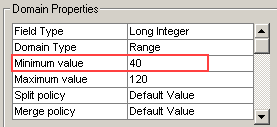Exploring the Geodatabase Data Model
The geodatabase is a data format introduced with ArcGIS®
software. Since you're taking this course, you may be wondering, "What
exactly is a geodatabase and why should I use
one?"
This lab
will introduce you to the basic features and functionality that a geodatabase provides. To really understand what a geodatabase is and how to put its powerful capabilites to work, however, you'll need to know about
subtypes, domains, relationships, and more. Each of these advanced data model
components can be implemented in a standard geodatabase.
If you don't understand the geodatabase terminology you just read, don't worry—you'll be introduced to these components in the labs that follow. For now, you'll start by getting familiar with the geodatabase itself.
Learning
objectives
A student
who completes this module will be able to:
- explain how the geodatabase stores geographic data
- understand the differences
between the two types of geodatabases
- describe the three primary
components of the geodatabase
- name other components that can
be stored in a geodatabase
- create a raster dataset in a
personal geodatabase
- access information about a geodatabase and its components
Test drive a geodatabase
Think of this first
exercise as being like taking a new car out for a test drive. You'll try out a
few features to see some of the functionality offered by the geodatabase. Using ArcMap, you'll work with attribute
domains to make valid edits to features in a geodatabase.
You'll also solve a problem affecting water mains in a geometric network.
If you have an ArcEditor or ArcInfo license, you
can do two steps at the end of this exercise that show you how to use
relationships and edit a network. If you're working with ArcView,
just read through those steps and look at the View Result graphics to get an
idea of the additional functionality supported by the geodatabase.
Estimated time to complete: 30 minutes
Step 1 Start ArcMap and open a map
Start ArcMap and choose to
open an existing map.
Double-click Browse for
maps and navigate to your Lab06 folder. Double-click CityWaterS.mxd
to open that map document.
You see a map of a
subdivision. This subdivision contains lots with homes on them, two wells, and
water lines that are joined together to form a water network. The data for all
of these layers is contained in a single geodatabase.

Step 1a: Start ArcMap and open a
map
At the bottom of the Table
of Contents, click the Source tab.
The path
to the data source for the map layers displays at the top of the Table of
Contents. You can now see that
the source of the data shown in the map is a personal geodatabase
named CityWaterS.mdb.
You may need to scroll or
widen your Table of Contents to see the full path to the data source.

Step 1b: Start ArcMap and open a
map.
Click the Display tab.
Step 2 Add a new well feature to the subdivision
A major advantage of
storing data in a geodatabase is that you can
validate edits made to the data.
If your Editor toolbar is not displayed, click the Editor Toolbar button ![]() to display it. If you like, dock the Editor toolbar to your ArcMap window.
to display it. If you like, dock the Editor toolbar to your ArcMap window.
From the Editor menu,
choose Start Editing.
On the Editor toolbar, make sure the Task is set to Create New Feature. In
the Target dropdown list, choose Wells. (If you're using ArcView,
you will see only the Wells layer in the Target list).
![]()
Step 2a: Add a new well feature to
the subdivision
Next, click the Sketch
tool ![]() and click inside the southwest corner lot of
the subdivision to add a well.
and click inside the southwest corner lot of
the subdivision to add a well.

Step 2b: Add a new well feature to
the subdivision
Step 3 Add attribute data for the new well
Now that you've created a
new well feature, you need to add its depth attribute value.
On the Editor toolbar,
click the Attributes button ![]() .
.
Tip: If your Editor toolbar
is docked to the ArcMap window and you don't see the Attributes button, widen
your ArcMap window.
In the Attributes dialog,
the Depth value is currently shown as <null>.
Replace the null value
with 50 (feet) for the well depth.

Step 3: Add attribute data for the
new well
Close the Attributes dialog.
Step 4 Validate the attribute data
In the area where this
subdivision is located, state regulations specify that residential wells must
be between 40 and 120 feet deep. An attribute domain was created in the geodatabase to make sure that only lawful depth values are
associated with residential well features.
In this step, you'll check
to see that the well you just added, plus the two other wells, comply with state regulations.
Hold down your Shift key,
then click the Edit tool ![]() and select all three wells. Make sure no other
features are selected.
and select all three wells. Make sure no other
features are selected.
Tip: If you're having trouble selecting
the wells without selecting other features, from the Selection menu, choose Set
Selectable Layers. Make Wells the only selectable layer.

Step 4a: Validate the attribute
data
From the Editor menu,
choose Validate Features.
The well in the
northwestern lot is selected and a message tells you its Depth value is not
within the acceptable range.
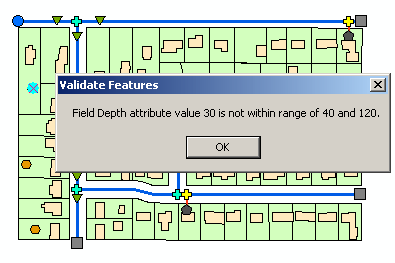
Step 4b: Validate the attribute
data.
Because this well's depth
is actually 60 feet, you know there has been a data entry error. You'll edit
the depth attribute for this well.
Click OK to close the message.
Step 5 Edit data and validate again
Open the Attributes
dialog. Change the depth value for the selected well to 60.

Step 5a: Edit data and validate
again
Close the Attributes
dialog.
From the Editor menu,
choose Validate Features again to make sure your edit is within the allowable
range.
All the wells should now
have valid values.
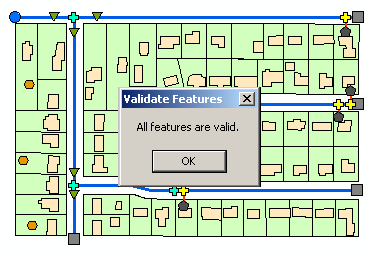
Step 5b: Edit data and validate
again
Click OK to close the validation message.
Step 6 Display the Utility Network Analyst toolbar
Your next task is to solve
a network problem using a geometric network that has been created in the geodatabase. The first five layers shown in the Table of
Contents participate in the network.

Step 6a: Display the Utility
Network Analyst toolbar
To access the network
functions, you need to display the Utility Network Analyst toolbar.
From the View menu, choose
Toolbars, then click Utility Network Analyst.

Step 6b: Display the Utility
Network Analyst toolbar.
If desired, dock the toolbar to your ArcMap window.
Step 7 Add a junction flag
In this and the remaining
steps, you will perform some basic network analysis. Don't worry about
memorizing the process you follow here—remember,
you're just on a test drive to see what the geodatabase
can do.
First, you'll perform an
upstream trace from the end of a water main back to the water tank, the origin
of flow for this network. Before you can perform a trace, you need to add a
junction flag at the water main location.
On the Utility Network
Analyst toolbar, click the Add Junction Flag tool ![]() .
.
Your mouse pointer changes
to a flag.
Using the graphic below
for reference, click the Cap junction at the end of the 6-inch water main line
to add a junction flag.
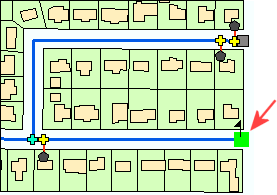
Step 8 Perform a trace operation
On the Utility Network
Analyst toolbar, in the Trace Task dropdown list, choose Trace Upstream.
Click the Solve button ![]() .
.
The flow path from the water tank (the network source) in the northwest
corner of the map to the junction flag you added displays in red.
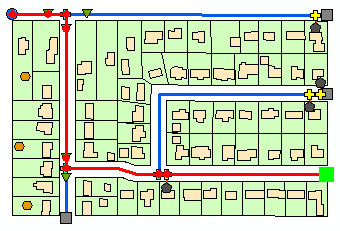
Step 8: Perform a trace operation.
From the Analysis menu, choose Clear Results. Again from the Analysis menu, choose Clear Flags.
Step 9 Test network connectivity
Several water customers
have called in to complain that their water pressure has suddenly dropped. You
suspect a broken pipe, and you want to identify the pipe that is common to all
the call locations.
Using the method described
in the previous step, set three junction flags at the water meter locations
shown below:
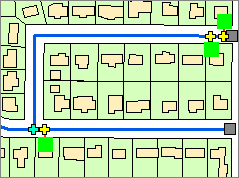
In the Trace Task dropdown
list, choose Find Common Ancestors.
Click the Solve button ![]() .
.
The break is probably on
the first highlighted pipe that is upstream from all the complaint locations.
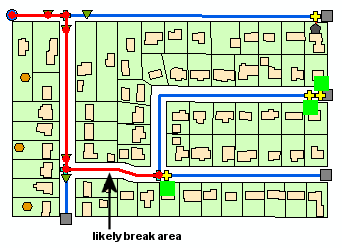
Step 9: Test network connectivity.
From the Analysis menu,
choose Clear Results. Again from the Analysis menu, choose Clear Flags.
If you are using ArcView to do this exercise, you will not be able to do the next two steps. Read through them, if you like, or skip to step 12.
Step 10 Remove lots and related houses (ArcEditor, ArcInfo users only)
The city is building a new
reservoir and needs the land currently occupied by some of the lots in the
southeastern portion of the subdivision. These lots and the houses on them will
be removed from the subdivision to make way for the reservoir (but don't worry,
the fictional homeowners are being well compensated for their forced
relocation).
If you set the Wells layer
to be the only selectable layer in step 4, change your selection settings so
that both the Lots and Fittings layers are selectable.
On the Editor toolbar, click the Edit tool ![]() and hold down your Shift key. Select the eight
lots as shown below.
and hold down your Shift key. Select the eight
lots as shown below.
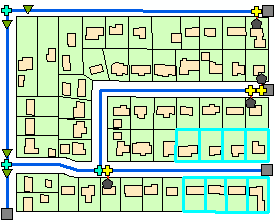
Make sure no other
features are selected.
Click the Delete button ![]() .
.
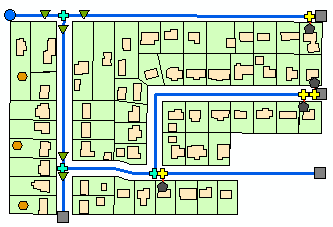
Step 10: Remove lots and related
houses (ArcEditor, ArcInfo
users only)
Notice that both the lots and the homes sitting on them have been removed from the subdivision. A relationship class was set up in the geodatabase between homes and lots. When the lots were deleted, the related homes were deleted as well.
Step 11 Edit the network (ArcEditor, ArcInfo users only)
Your final task is to edit
the water main. Because the eight lots were removed, the length of the water
main that served those homes needs to be adjusted.
The geodatabase
maintains connectivity between features in a network. When you move a network
feature, the features connected to it will also move.
Using the Edit tool,
select the Cap feature at the end of the water main.
Drag the Cap to the left,
to the end of the last lot, then click away from the
feature to unselect it.
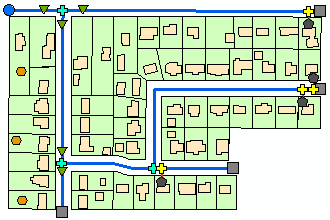
Step 11: Edit the network (ArcEditor, ArcInfo users only).
Step 12 Save your work
From the Editor menu,
choose Stop Editing. Click Yes to save your changes.
Save the map document, then close ArcMap.
Conclusion
In this exercise, you were
introduced to three geodatabase features: attribute
domains, geometric networks, and relationship classes. Together, these features
provide powerful tools for ensuring database integrity and finding answers to
common
Explore the structure of a geodatabase
In this exercise, you'll
get a different perspective on the geodatabase you
worked with in the first exercise. This time you'll look at it in ArcCatalog.
ArcCatalog is the ArcGIS application used to create and
manage geodatabases. ArcCatalog is also the place to
go when you need information about the structure of a geodatabase:
its feature datasets, feature classes, nonspatial
tables, and the other components that it may contain.
This exercise will teach
you how to access information about the structure of geodatabase
components.
Estimated time to complete: 30 minutes
Step 1 Open ArcCatalog and create a connection to the exercise data
Open ArcCatalog.
You'll first create a
connection to the exercise data folder for this course—by doing so, you'll be able to quickly get to the data for each
module.
Click the Connect to
Folder button ![]() and navigate to your Lab06 folder. Click
the Geodatabases folder.
and navigate to your Lab06 folder. Click
the Geodatabases folder.

Step 1: Open ArcCatalog
and create a connection to the exercise data.
Click OK to create the
folder connection.
The new folder connection
displays in the Catalog tree.
Step 2 Examine the geodatabase in the Catalog tree
In the Catalog tree,
expand the folder connection you just created, then
expand the Explore folder.
You see the personal geodatabase named CityWaterS.mdb that you worked with in
the previous exercise.
Expand the CityWaterS.mdb geodatabase.
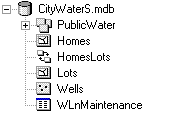
Step 2: Examine the geodatabase in the Catalog tree.
This geodatabase
contains one feature dataset named PublicWater, three
standalone feature classes (Homes, Lots, and Wells), one table of nonspatial data named WLnMaintenance,
and a relationship class named HomesLots.
The relationship class establishes how the Homes features are related to the Lots features. You saw an effect of this relationship in the previous exercise when you deleted the lots and the homes were deleted automatically. You'll learn about relationship classes in Module 4 of this course.
Step 3 Examine the feature dataset
The PublicWater
feature dataset contains the network features you worked with in the previous
exercise.
Expand PublicWater
to see its contents.

Step 3: Examine the feature
dataset.
The first five items
listed in PublicWater are user-defined feature
classes. The last two items, WaterNet and WaterNet_Junctions, were created by the software when the
geometric network was created.
All the components in the PublicWater feature dataset work together to form an integrated network that allowed you to trace the flow of water through the water lines and locate a broken pipe.
Step 4 Preview the Wells feature class
In the previous exercise,
you created a new well feature and added attribute data for it. This data was
stored in the Wells feature class. In this step, you'll find out more about
this feature class.
In the Catalog tree, click
the Wells feature class, then click the Preview tab on the right to preview the
geography of Wells.
You see three well
features. Each feature is stored as a row in the feature class table.
Note: If you didn't complete the first
exercise, you will see only two wells.
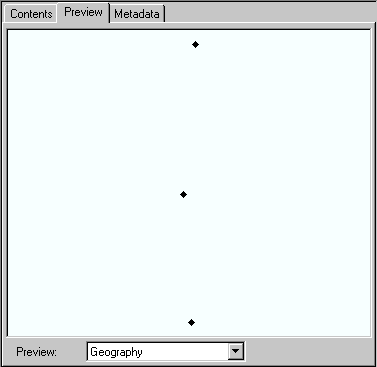
Step 4a: Preview the Wells feature
class.
In the Preview dropdown
list at the bottom of the Preview area, choose Table.
The OBJECTID and SHAPE
fields were automatically generated by the software. The Depth field is a
user-defined attribute field.
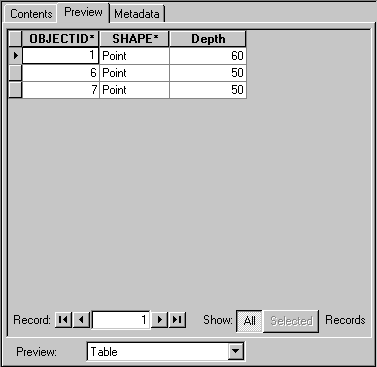
Step 4b: Preview the Wells feature
class.
Step 5 Examine feature class properties
In ArcMap, you can see
features and their attributes. In ArcCatalog, however,
you can get more information about feature classes.
Right-click Wells and
choose Properties.
The Feature Class
Properties dialog displays. Click the Fields tab.
The three fields in the
Wells feature class table are listed along with the type of data each field can
contain.
Click the gray box to the
left of Depth.
The properties of the
Depth field display in the middle of the dialog.
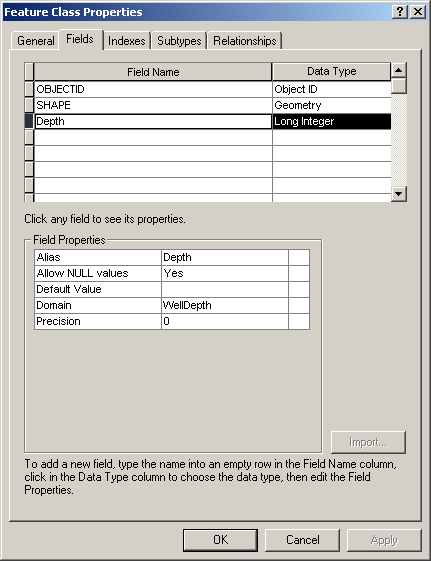
Step 5a: Examine feature class
properties.
Notice that there is a
domain called WellDepth associated with this field.
You'll find out more about this domain in the next step.
Click the Subtypes tab.
If the well features had
been grouped into subtypes, the subtypes would be described in this panel.
However, you can see that the Wells feature class has no subtypes.
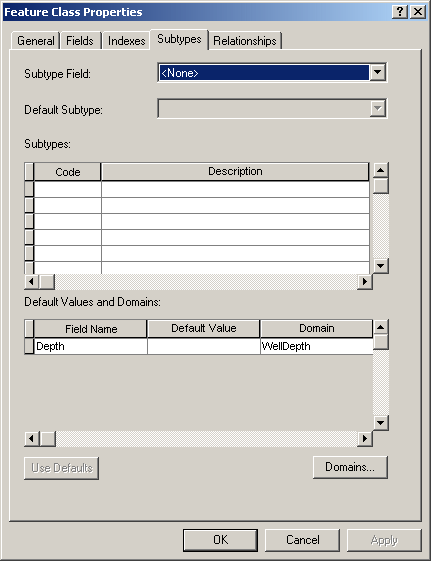
Step 5b: Examine feature class
properties.
Click the Relationships
tab.
![]() 1 Does the Wells feature class participate in
any relationships?
1 Does the Wells feature class participate in
any relationships?
Click Cancel to close the Feature Class Properties dialog.
Step 6 Examine the geodatabase properties
What properties are
associated with the geodatabase as a whole?
To find
out, right-click CityWaterS.mdb and choose Properties.
Click the Domains tab.
You see information on the
domains associated with the geodatabase.
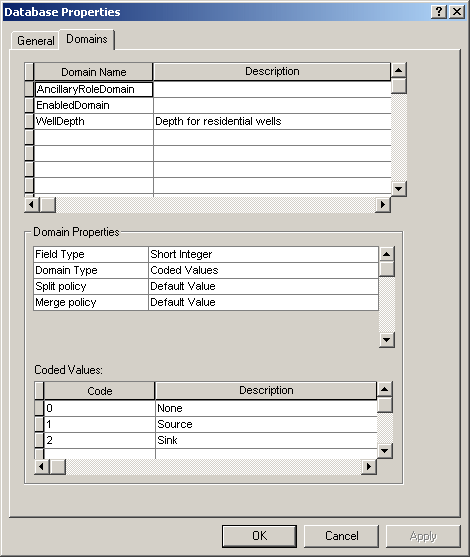
Step 6: Examine the geodatabase properties.
At the top of the dialog,
three domains are listed. The first two domains, AncillaryRoleDomain
and EnabledDomain, are part of the geometric network.
The third domain, WellDepth, is the domain you used
in the previous exercise to validate well depths.
Click the gray box to the
left of WellDepth.
The domain properties
display in the middle of the dialog.
![]() 2 What is the minimum value for a well's
depth, as specified by this domain?
2 What is the minimum value for a well's
depth, as specified by this domain?
You'll learn how to create
attribute domains in Lab 9.
Close the Database Properties dialog.
Step 7 Create a standalone feature class
There are several ways to
create a feature class in a geodatabase. In the next
two modules, you'll get lots of practice creating feature classes. For now,
you'll try one method.
Right-click
CityWaterS.mdb, click New, then click Feature Class.
The New Feature Class
dialog displays.
For Name, type Roads.

Step 7a: Create a standalone
feature class.
Click Next.
Accept the default keyword
configuration option and click Next.
In the third panel, click
the gray box next to SHAPE.
In the field properties
area, notice that the default Geometry Type is polygon.
Click in the column next
to Geometry Type and choose Line in the dropdown list.
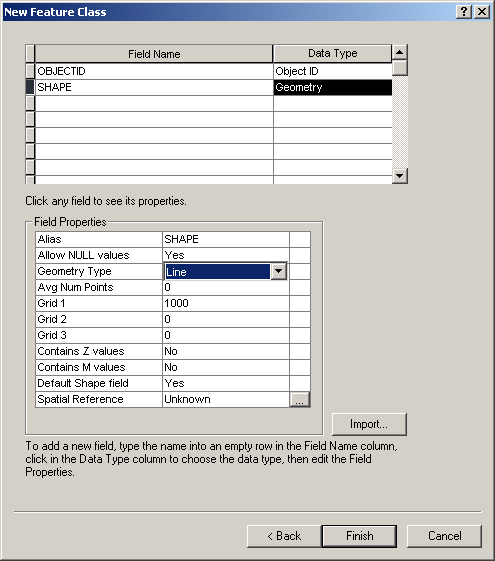
Step 7b: Create a standalone
feature class.
Next, you'll add an
attribute field.
At the top of the dialog,
click in the empty cell below SHAPE. Type RoadName
and press Tab to move to the Data Type column.
The default data type is
Text, the appropriate data type for this field.
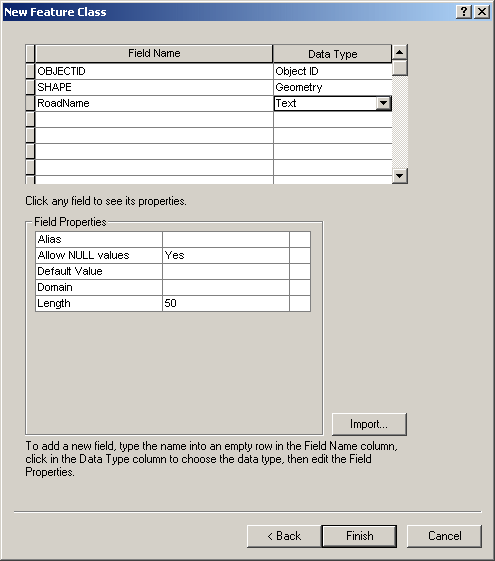
Step 7c: Create a standalone
feature class.
Click Finish.
The new Roads feature
class is created and displays in the Catalog tree.
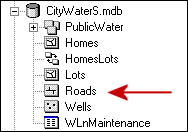
Step 7d: Create a standalone
feature class.
Preview the table for the
Roads feature class.
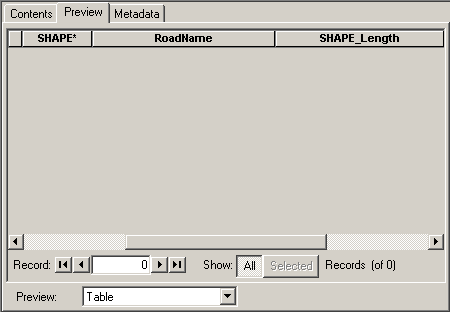
Step 7e: Create a standalone
feature class.
Notice the SHAPE_Length field. The geodatabase
automatically stores and maintains length values for line features.
The feature class structure has now been created. The next step would be to add its features and attribute data using the ArcMap editing tools. You'll learn how to create features and attributes in Module 3 of this course.
Step 8 Explore on your own
In steps 4 and 5, you
learned how to use Preview and the Properties dialog to find out more about the
Wells feature class. Use the same methods to get information about the other CityWaterS geodatabase components
you see listed in the Catalog tree.
Here are a few suggestions
to get you started:
- Look at the properties for the WLnMaintenance
table. How do nonspatial table properties differ
from those for a feature class?
- Expand the PublicWater feature dataset
and examine the properties of its feature classes. In particular, examine
how the feature class subtypes are defined.
- Not all the items you see in the Catalog tree can be previewed.
Which items can't be previewed and why do think this might be?
Don't worry if you can't
find the answers to these questions now. You'll learn them in the modules that
follow.
When you're finished exploring the geodatabase, close ArcCatalog.
Conclusion
As you discovered in this
exercise, you can get a lot of information about a geodatabase,
its structure, what its various components look like, and how they work
together by using ArcCatalog's Preview tab and
Properties dialogs.
Throughout this course, you will work with both ArcCatalog and ArcMap to create and edit geodatabase features.
Explore
raster data
In this exercise, you will
get a brief introduction to working with rasters in a
geodatabase.
Using ArcCatalog,
first you will create a new raster dataset in a personal geodatabase
and examine a raster catalog that has already been created. Then, using Windows
Explorer, you'll look at the differences between the file structure for a
managed raster and an unmanaged raster.
Estimated time to
complete: 20 minutes
Step 1 Open ArcCatalog and navigate to the exercise
data
Start ArcCatalog
and expand your Geodatabases folder connection. Expand the Explore
folder.
You see the
AlachuaCounty.mdb personal geodatabase.
Expand AlachuaCounty.mdb.

Step 1: Open ArcCatalog
and navigate to the exercise data
This geodatabase
contains one feature dataset (Administrative), a raster catalog (StudyArea2)
which you'll explore in later steps, and a standalone feature class (MajorRoads).
Step 2 Examine raster properties
In the next step, you will
create a raster dataset in the AlachuaCounty geodatabase. The data stored in this raster dataset will be
a mosaic of the three MrSid images: aerial_east.sid, aerial_south.sid,
and aerial_west.sid.
Before creating the raster
dataset, you'll take a look at the images.
In the Catalog tree, click
aerial_east.sid, then click the Preview tab to see
the image.
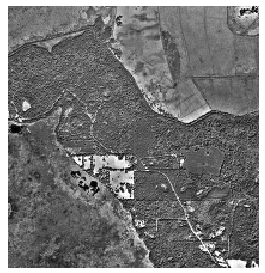
Step 2a: Examine raster properties
In the Catalog tree,
right-click aerial_east.sid and choose Properties.

Step 2b: Examine raster properties.
Scroll down through the
dialog and examine all the properties for aerial_east.
![]() 3 In what coordinate system is this image
stored? Hint: Look next to Spatial Reference.
3 In what coordinate system is this image
stored? Hint: Look next to Spatial Reference.
Close the dialog.
To mosaic images together
into a single raster dataset, each of the images must have the same properties
(number of bands, cell size, format, and spatial reference).
Preview the aerial_south.sid and aerial_west.sid
images and examine their properties.
![]() 4 Do these images have the same properties as aerial_east?
4 Do these images have the same properties as aerial_east?
Another criteria
for mosaicking is that the images must be adjacent.
If you were to add these three images to ArcMap, you would see that they
overlap, as shown in the graphic below.
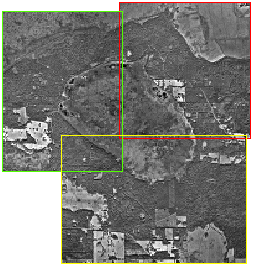
The overlaps will be
removed when you add the data to the raster dataset.
Step 3 Create a new raster dataset
There are several ways to
get raster data into a geodatabase. The method you
will use in this step and the next is to create an empty raster dataset and
then load the three images into it.
In the Catalog tree,
right-click AlachuaCounty.mdb, choose New, then click
Raster Dataset.
The Create Raster Dataset
tool opens. If you like, you can resize the tool dialog.
In the box under
"Raster dataset name with extension," enter StudyArea1.

Step 3a: Create a new raster
dataset.
The defaults for cellsize, pixel type, and number of bands are appropriate,
so you do not need to change them. The coordinate system information will be
provided by the images you add to the raster dataset.
Click OK.
The progress window shows
the status of the processing. When the process is complete,
close the progress window.
The new raster dataset has
been added to the geodatabase.

Step 3b: Create a new raster
dataset.
Step 4 Load the raster images
In this step, you will
load the data from the three images into the StudyArea1 raster dataset.
Right-click StudyArea1,
choose Load, then click Load Data.
The Mosaic tool opens.
You need to specify the
three images that you want to load. The easiest way is to drag and drop the
images into the tool from the Catalog tree.
Move your Mosaic tool
dialog so that you can see both it and your ArcCatalog
window.
In the Catalog tree, click
aerial_east.sid and drag it into the Input Rasters box in the Mosaic tool.
Drag aerial_south.sid
and aerial_west.sid into the box.

Step 4: Load the raster images.
You will accept all the
default options for mosaicking the image data.
Click OK.
When processing is
complete, close the progress window.
The image data has been
added to the raster dataset.
Step 5 Preview the new raster dataset
In the Catalog tree, click
StudyArea1 and preview the new image.
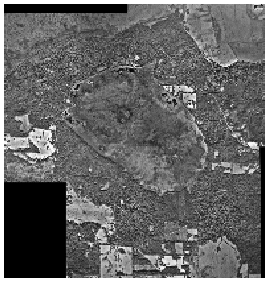
Step 5a: Preview the new raster
dataset.
A new, seamless image has
been created from the three image files. Notice the oval area in the center of
the image—this is a wetlands area. Notice also that the areas of overlap among
the three images have been eliminated in the new image.
Right-click StudyArea1 and
choose Properties.

Step 5b: Preview the new raster
dataset.
Under Data Source, you can
see that the raster dataset is being managed by the geodatabase.
Notice under Raster
Information that the format is ERDAS IMAGINE.
Remember that a personal geodatabase references raster data. When you load data into
a raster dataset in a personal geodatabase, ArcCatalog mosaicks the data,
saves the mosaic as an ERDAS IMAGINE file (.img), and
stores the file in a folder that has the same name as the geodatabase.
You don't see this folder in ArcCatalog.
In step 9, you'll use
Windows Explorer to examine the file structure of the data referenced by the
StudyArea1 raster dataset.
Close the dialog.
Step 6 Examine raster catalog properties
You'll now explore the
second way that the geodatabase references raster
data—a raster catalog.
A raster catalog named
StudyArea2 has already been created in the AlachuaCounty
geodatabase.
In the Catalog tree, click
StudyArea2 and preview the raster data.
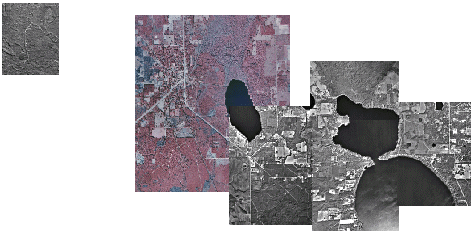
Step 6a: Examine raster catalog
properties.
All the images in the
catalog are displayed. Notice that unlike a raster dataset, the images loaded
into a raster catalog don't have to be adjacent.
Preview the table for
StudyArea2.

Step 6b: Examine raster catalog
properties.
A raster catalog is a
collection of rasters. Each record in the table
corresponds to one raster. The Raster column stores the reference to the image
files. The Shape_Length and Shape_Area
fields are added by the geodatabase to store the
perimeter and area of the raster footprints.
The StudyArea2 catalog
contains six rasters.
Click the Contents tab.
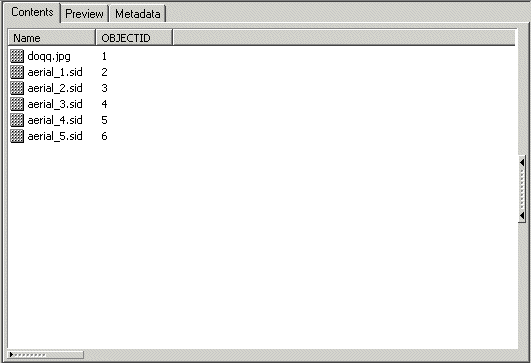
Step 6c: Examine raster catalog
properties.
The names of the
referenced rasters are also listed here.
On the right side of the
Contents tab is the Expand/Contract Window button.
![]()
Click the button to expand
the window.
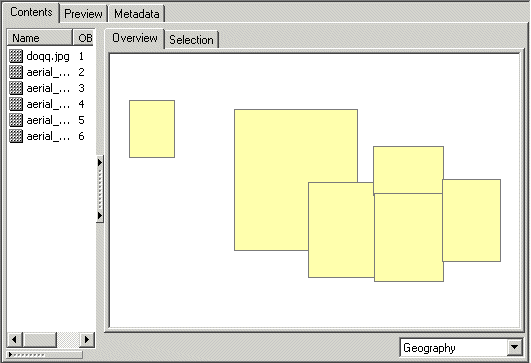
Step 6d: Examine raster catalog
properties.
The footprints for all the
rasters in the raster catalog are shown in the
Overview tab.
Step 7 View raster properties in the catalog
Using the Contents tab,
you can access information about each raster in the raster catalog.
In the Contents tab, under
Name click doqq.jpg to select the image.
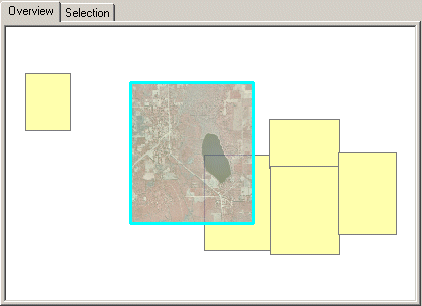
Step 7a: View raster properties in
the catalog.
The Overview tab shows the
selected image.
Click the Selection tab to
see a larger view of the selected image.
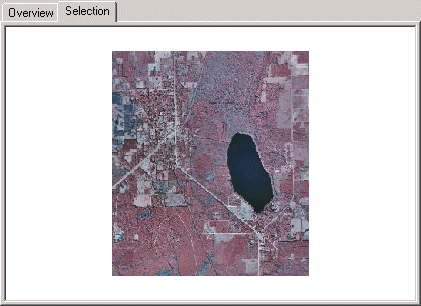
Step 7b: View raster properties in
the catalog.
You can also access
metadata, properties, and a list of bands for each raster in the catalog.
In the dropdown list at
the bottom right corner, choose Properties.

Step 7c: View raster properties in
the catalog.
You see the properties for
the selected raster.
Under Data Source, notice
that this raster is not managed by the geodatabase
(its "Managed by GDB" property is No). Because the data is not
managed by the geodatabase, if you were to copy the geodabase to a different location, the referenced images
would not follow.
Notice also under Data
Information that the format is JPEG, not ERDAS IMAGINE. When it is not managed
by the geodatabase, raster source data remains in its
original format instead of being converted to .img
format.
Under Raster Information,
notice that this image has three bands and the cell size is 3,3
(each pixel in the image represents 3 x 3 meters on the ground). You'll compare
this information to another image in the next step.
Step 8 Examine another raster in the catalog
In the Contents tab under
Name, click aerial_2.sid to view its properties. You may need to widen the Name
column to see the full raster filenames.

Step 8a: Examine another raster in
the catalog.
Notice that this image has
only one band and the cell size is 2,2.
Unlike rasters
added to a raster dataset, rasters in a raster
catalog can have different properties. To be viewable, though, all the rasters in a raster catalog must have the same spatial
reference.
From the dropdown list,
choose Geography. Click the Overview tab.
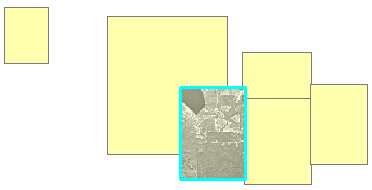
Step 8b: Examine another raster in
the catalog.
This image overlaps the
image you examined in the previous step. In a raster dataset, areas of overlap
are eliminated. In a raster catalog, the data for all the rasters
is preserved.
To preview both images,
hold down the Ctrl key and click doqq.jpg.
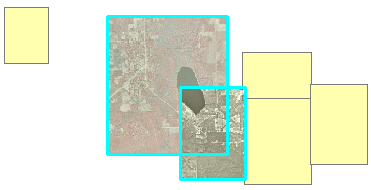
Step 8c: Examine another raster in
the catalog.
Step 9 Compare managed and unmanaged rasters
In this exercise, you have
worked with both managed (StudyArea1) and unmanaged (StudyArea2) raster data.
To understand the
differences in how the data is stored, you'll look at the data in Windows
Explorer.
Minimize ArcCatalog.
Open Windows Explorer and
navigate to your Lab06 folder. Expand the Explore folder.
![]()
Step 9a: Compare managed and
unmanaged rasters.
You see a folder with the
same name (but with an .idb extension), and at the
same level in the folder structure, as the geodatabase.
This folder contains the reference information for the StudyArea1 and
StudyArea2 items in the AlachuaCounty geodatabase.
Expand the AlachuaCounty.idb folder, then
open the c_4 folder.

Step 9b: Compare managed and
unmanaged rasters.
Note: Depending on your ArcGIS settings,
you may or may not see a file with the .rrd
extension. If you have the option set to automatically create pyramid files,
you will see the file.
When you loaded the data
into the StudyArea1 raster dataset, the images were mosaicked
and the mosaic was saved as an ERDAS IMAGINE (.img)
file and added to this subfolder.
Raster datasets are always
managed by the geodatabase. In ArcCatalog,
you see the raster dataset inside the geodatabase.
When you view the data in Windows Explorer, you can see that the data is
actually stored in a separate folder.
It's important to always
use ArcCatalog to copy or move your
There is no subfolder for
the StudyArea2 raster catalog because the catalog is not being managed by the geodatabase. The AlachuaCounty.idb
folder just contains a pointer to the original images.
Close Windows Explorer.
Step 10 Compare raster data and vector data
Restore ArcCatalog.
In the exercises in this
module, you've worked with vector data (feature datasets and feature classes)
and raster data (raster catalogs and raster datasets).
Take a moment to compare
and contrast what you've learned about the different types of data structures
in the geodatabase using the AlachuaCounty
geodatabase.
In the Catalog tree,
expand the Administrative feature dataset.
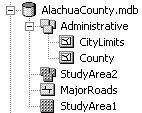
Step 10: Compare raster data and
vector data.
A feature dataset contains
feature classes (CityLimits and County) that share
the same spatial reference. Each feature class contains one type of vector
feature (point, line, or polygon). The CityLimits and
County feature classes each contain polygon features. Feature classes can be
grouped together in a feature dataset or exist as a standalone object, like the
MajorRoads feature class. Feature class data is
stored in the geodatabase.
A raster catalog like StudyArea2
contains rasters that share the same spatial
reference. Different types of rasters can be
organized into one raster catalog. Contiguous rasters
with the same properties can be added to a raster dataset, like StudyArea1.
Raster data is stored outside the geodatabase.
When you have finished
looking at the data, close ArcCatalog.
Conclusion
This exercise showed you
some of the differences between a raster dataset and a raster catalog. You also
examined the differences between the file structure for managed and unmanaged
raster data in a personal geodatabase.
Throughout the rest of
this course, you will be working with vector data.
Now that you've had an
introduction to geodatabases, you're ready to start exploring them in more
depth. In the next module, you learn how to create a personal geodatabase using ArcCatalog.
Review
Geodatabases
have an extensive range of functionality and offer many advantages for GIS
users. This module introduced you to some basic features of the geodatabase. Listed below are key points you should
remember:
· A geodatabase
is a relational database that stores geographic data.
· There are two types of
geodatabases: personal and enterprise.
· Feature classes, feature datasets,
and nonspatial tables are the primary components of a
geodatabase.
· There are three types of topology
that can be created for data stored in a geodatabase:
geodatabase topology, map topology, and the topology
created for a geometric network. The nature of your analysis will determine
what type of topology, if any, you will need to create.
· Two types of raster objects can be
created in a geodatabase: raster datasets and raster
catalogs. An enterprise geodatabase stores raster
data, while a personal geodatabase references raster
data.
